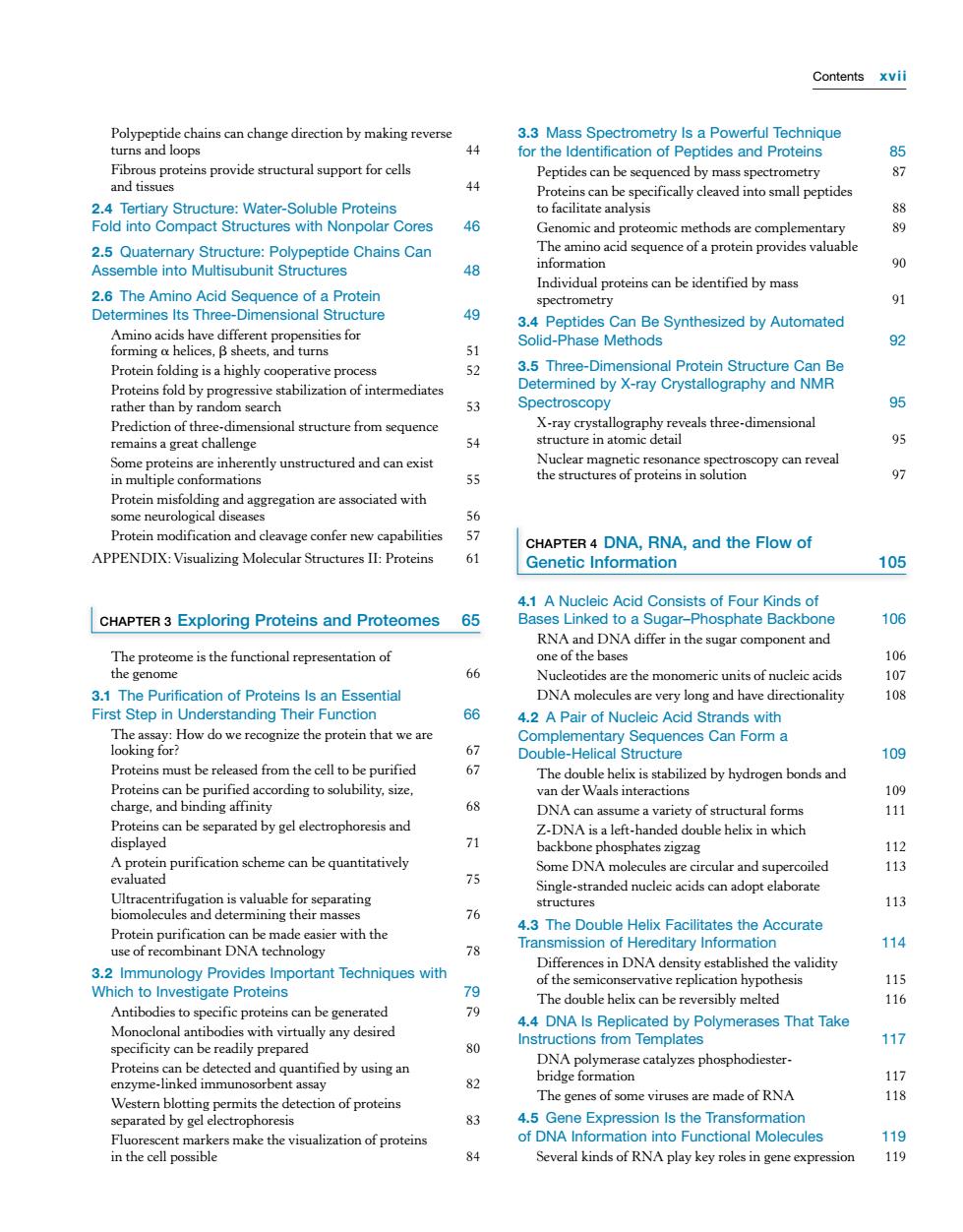正在加载图片...

Contents xvii Polypepe hains can chng direction by making revrse 3.3 Mass Spectrometry Is a Powerful Technique s provide structural support for cells ation of Peptides and Proteins es can 87 4 2.4 Tertiary Structure:Water-Soluble Proteins 88 Fold into Compact Structures with Nonpolar Cores Genomic and proteomic methods are complementary 89 2.5 Quaternary Structure:Polypeptide Chains Can Assemble into Multisubunit Structures 90 2.6 The Amino Acid Sequence of a Protein Individual proteins can be identified by mass Determines Its Three-Dimensional Structure 91 3.4 Peptides Can Be Synthesized by Automated ensities for Solid-Phase Methods 92 55 3.5 Three-Dimensional Protein Structure Can Be mediates Determined by X-ray Crystallography and NMR roscop 95 nsional structure from sequence 95 ns a grea 54 tly unstructured and can exist Nucle copy can reveal 55 capabilities CHAPTER 4 DNA,RNA,and the Flow of APPENDIX:Visualizir tructures II:Protein Genetic Information 105 CHAPTER 3 Exploring Proteins and Proteomes 65 hate Ba 106 RNA and DNA differ in the sugar component and The proteome is the functional representation of one of the bases 106 66 re the m s Is an E ssential A molecules are very l ng and have directionality 108 .2 do w n that we are 87 Double-Helical Structure 109 m the Hfinecordingtosok r Wa 19m 71 backbone phosphates zigzag 112 Some DNA molecules are circular and supercoiled 113 Single-stranded nucleic acids can adopt elaborate 113 76 vith the Accurate 114 Differences in DNA density established the validity 3.2 Immunology Provides Important Techniques with Which to Investigate Proteins rvative replication hypothesis Antibodies to specific proteins can be generated 116 with virtually any desired 4.4 DNA Is Replicated by Polymerases That Take 80 117 Proteins antified by using an catalyzes phosphodicster 117 nzym assay The genes of some viruses are made of RNA 118 83 4.5 Gene Expression Is the Transformatio rs make the visualization of proteins of DNA Infe mation into Functional Molecules 84 Several kinds of RNA play key roles in gene expression 119Contents xvii Polypeptide chains can change direction by making reverse turns and loops 44 Fibrous proteins provide structural support for cells and tissues 44 2.4 Tertiary Structure: Water-Soluble Proteins Fold into Compact Structures with Nonpolar Cores 46 2.5 Quaternary Structure: Polypeptide Chains Can Assemble into Multisubunit Structures 48 2.6 The Amino Acid Sequence of a Protein Determines Its Three-Dimensional Structure 49 Amino acids have different propensities for forming a helices, b sheets, and turns 51 Protein folding is a highly cooperative process 52 Proteins fold by progressive stabilization of intermediates rather than by random search 53 Prediction of three-dimensional structure from sequence remains a great challenge 54 Some proteins are inherently unstructured and can exist in multiple conformations 55 Protein misfolding and aggregation are associated with some neurological diseases 56 Protein modification and cleavage confer new capabilities 57 APPENDIX: Visualizing Molecular Structures II: Proteins 61 CHAPTER 3 Exploring Proteins and Proteomes 65 The proteome is the functional representation of the genome 66 3.1 The Purification of Proteins Is an Essential First Step in Understanding Their Function 66 The assay: How do we recognize the protein that we are looking for? 67 Proteins must be released from the cell to be purified 67 Proteins can be purified according to solubility, size, charge, and binding affinity 68 Proteins can be separated by gel electrophoresis and displayed 71 A protein purification scheme can be quantitatively evaluated 75 Ultracentrifugation is valuable for separating biomolecules and determining their masses 76 Protein purification can be made easier with the use of recombinant DNA technology 78 3.2 Immunology Provides Important Techniques with Which to Investigate Proteins 79 Antibodies to specific proteins can be generated 79 Monoclonal antibodies with virtually any desired specificity can be readily prepared 80 Proteins can be detected and quantified by using an enzyme-linked immunosorbent assay 82 Western blotting permits the detection of proteins separated by gel electrophoresis 83 Fluorescent markers make the visualization of proteins in the cell possible 84 3.3 Mass Spectrometry Is a Powerful Technique for the Identification of Peptides and Proteins 85 Peptides can be sequenced by mass spectrometry 87 Proteins can be specifically cleaved into small peptides to facilitate analysis 88 Genomic and proteomic methods are complementary 89 The amino acid sequence of a protein provides valuable information 90 Individual proteins can be identified by mass spectrometry 91 3.4 Peptides Can Be Synthesized by Automated Solid-Phase Methods 92 3.5 Three-Dimensional Protein Structure Can Be Determined by X-ray Crystallography and NMR Spectroscopy 95 X-ray crystallography reveals three-dimensional structure in atomic detail 95 Nuclear magnetic resonance spectroscopy can reveal the structures of proteins in solution 97 CHAPTER 4 DNA, RNA, and the Flow of Genetic Information 105 4.1 A Nucleic Acid Consists of Four Kinds of Bases Linked to a Sugar–Phosphate Backbone 106 RNA and DNA differ in the sugar component and one of the bases 106 Nucleotides are the monomeric units of nucleic acids 107 DNA molecules are very long and have directionality 108 4.2 A Pair of Nucleic Acid Strands with Complementary Sequences Can Form a Double-Helical Structure 109 The double helix is stabilized by hydrogen bonds and van der Waals interactions 109 DNA can assume a variety of structural forms 111 Z-DNA is a left-handed double helix in which backbone phosphates zigzag 112 Some DNA molecules are circular and supercoiled 113 Single-stranded nucleic acids can adopt elaborate structures 113 4.3 The Double Helix Facilitates the Accurate Transmission of Hereditary Information 114 Differences in DNA density established the validity of the semiconservative replication hypothesis 115 The double helix can be reversibly melted 116 4.4 DNA Is Replicated by Polymerases That Take Instructions from Templates 117 DNA polymerase catalyzes phosphodiesterbridge formation 117 The genes of some viruses are made of RNA 118 4.5 Gene Expression Is the Transformation of DNA Information into Functional Molecules 119 Several kinds of RNA play key roles in gene expression 119 CHAPTER 3 Exploring Proteins and Proteomes 65 CHAPTER 4 DNA, RNA, and the Flow of Genetic Information 105